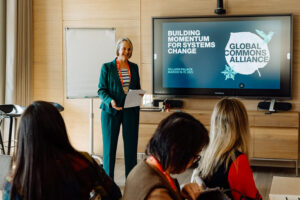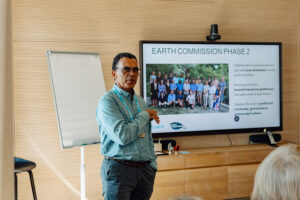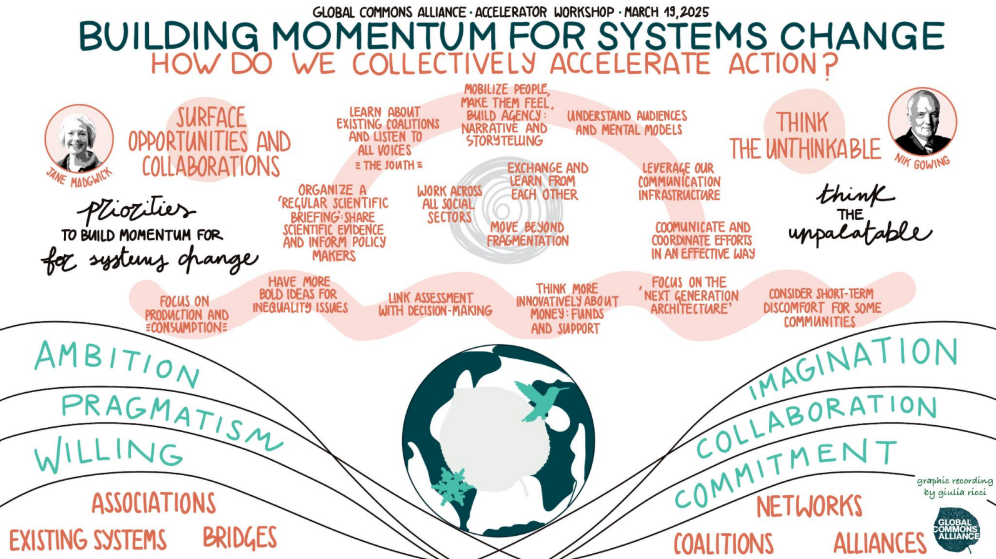Uniting for systems change at Villars Summit
26/03/2025
The Global Commons Alliance and partners joined entrepreneurs, investors, lawyers, scientists and civil society leaders from around the world at the Villars Institute Summit 2025 in Switzerland last week, to unite behind systems change for a Safe and Just future.
The third annual Villars Summit to address the climate and nature crisis took place the same week South Korea battled wildfires and flash floods hit Spain. There’s no escaping the impacts of an unstable global commons. But as the GCA Earth Commission’s science tells us, if economic systems, resource management and technologies are dramatically transformed, the planet can gain stability. This bold ambition was threaded throughout the sessions at Villars Summit, with leaders across sectors converging on the need for urgent systems change to safeguard the global commons we all depend on.
Ahead of the main summit, GCA hosted an accelerator workshop with the support of the Villars Institute and moderated by Nik Gowing, Founder and Director of Thinking the Unthinkable, on how to build momentum for systems change. Earth system scientists began by citing the urgency to act based on “unequivocal evidence” that we are fast approaching irreversible tipping points.
Peace and security require Earth system stability.
Speaker at the Global Commons Alliance workshop
- Jane Madgwick, the GCA
- Margarita Astralaga, the GCA
- David Obura, Earth Commissioner
In the first session speakers reiterated our huge planetary challenges, including the need to turn agriculture from a carbon emission source to a carbon sink within the next decade, alongside restoring the biosphere at scale, and drastically reducing emissions. It was agreed that the journey back to a stable, liveable planet will be non-linear.
Against a backdrop of growing nationalism, attacks on science and some governments and businesses reversing climate and nature commitments – supporting the summary of workshop conclusions by Jane Madgwick, Executive Director, the GCA – participants agreed that:
- Messaging based on Earth system science must get “louder” and more frequent to be heard.
- Applying a risk and resilience lens, we need to emphasise the power of nature to enable human security, health and economic stability.
- Our entire community must unite to become stronger together, since the speed and scale of transformations needed are like nothing we have tackled before.
- We have to enable sectors to work together more cohesively, so that legal and governance mechanisms mesh with the demands of influencer and activist networks.
- It’s not just a question of finance. We have to drop our egos and brands, get organized, focus together and connect to bring about change.
Our community needs to act better as an ecosystem. No single alliance, organisation, government, company or institution, can make the difference alone.
Jane Madgwick, Executive Director, the GCA
The Safe and Just Boundaries science was outlined in a session with Professor Johan Rockström, Co-chair of the Earth Commission and Director of the Potsdam Institute for Climate Impact Research, and David Obura, CORDIO East Africa and Earth Commissioner. It was agreed that not only does this science need to be better understood holistically, but that mobilizing people into action needs a better blend of “motivators”, including inspiration and solutions as well as fear.
This discussion set the scene for identifying ways to stimulate proportional system shifts in response to the science in the next half of the session, which was led by Margarita, Chair of the GCA, together with Wendy Broadgate, Executive Director, Earth Commission, and Rachel Jetel, Co-Director of Systems Change Lab. Catalysts included innovation and behavior change alongside enabling policy regulation and incentives. Click to expand the session summary illustrations below.
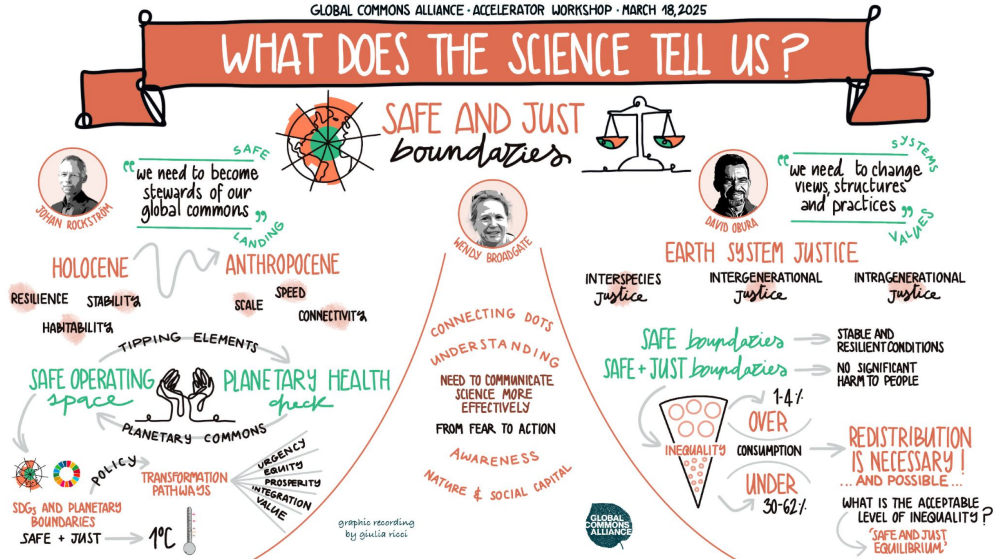
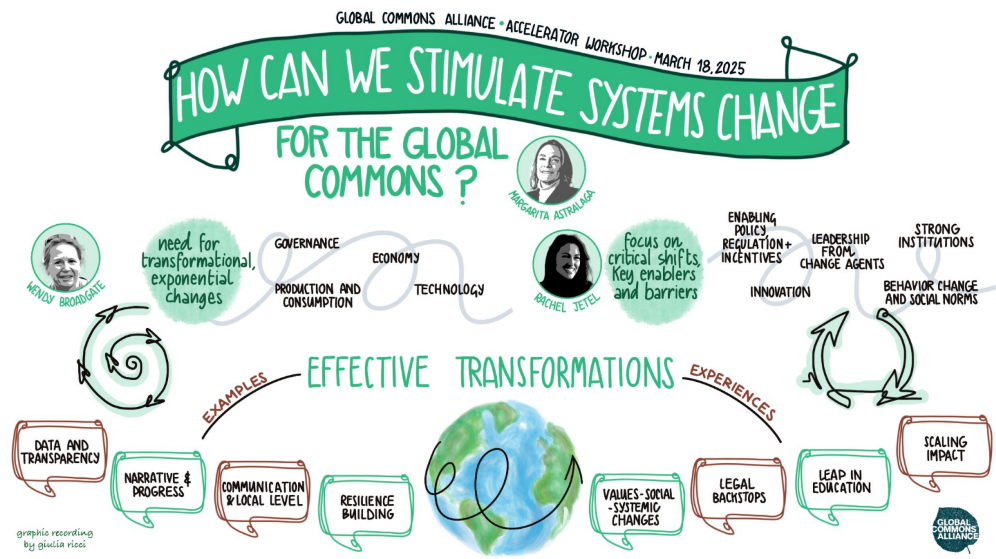
But transformational shifts won’t happen without mass public support. Framed by Thijs Biersteker’s dynamic “data-driven sculptures” that are designed to help people understand ecological challenges and be moved to action, the second session of the workshop was about shifting popular opinion to demand positive change, with Tim Kelly, Earth HQ; Rhett Ayers Butler, Mongabay; Dr. Jemilah Mahmood, Sunway Centre for Planetary Health, and Sweta Chakraborty of We Don’t Have Time.

Tim Kelly, Earth HQ; Dr. Jemilah Mahmood, Sunway Centre for Planetary Health; Rhett Ayers Butler, Mongabay, and Sweta Chakraborty of We Don’t Have Time
Approaches to overcome misinformation in order to shift public opinion included focusing on solutions as well as problems, making sure that southern voices are heard, better communicating that planetary health includes human health, and prioritizing influencer-driven engagement. The below illustration shows some of the session’s top ideas.
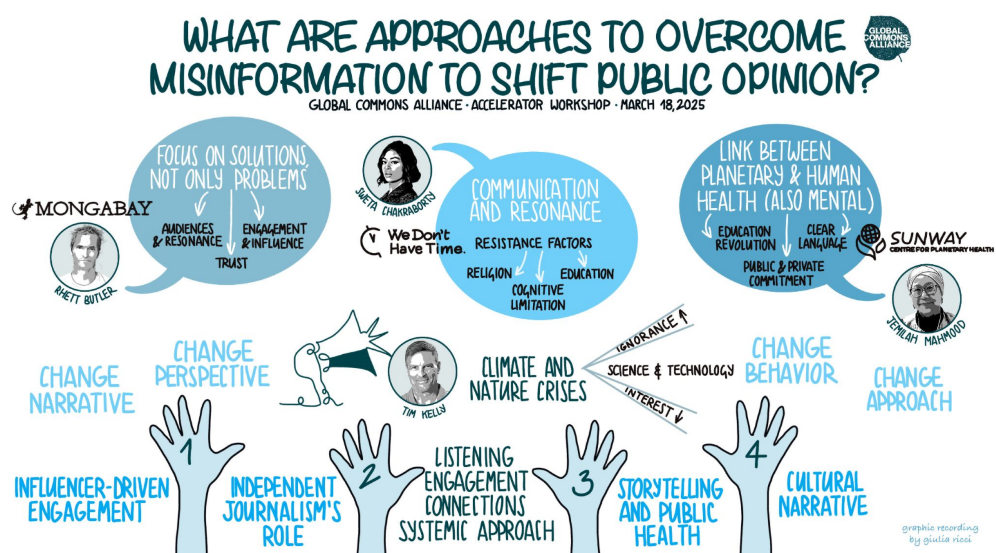
Even with public demand, an enabling environment is needed for system transformation to happen. Inspiration and willingness needs some leadership, frameworks and channels to convert into decisions that result in real change.
Jane Madgwick, GCA, moderated a session to explore some of the most promising policy, legal and governance solutions with Jean Oelwang, Planetary Guardians; Natalia Greene, Global Alliance for the Rights of Nature; Maja Groff, Climate Governance Commission and Anja Olin-Pape, Global Challenges Foundation, in which it was agreed that planetary science must be both connected into other holistic solutions, and shared more effectively with decision-makers. It was suggested that bringing understanding to politicians is best achieved in small, trusted spaces, where questions can be asked and answered without fear.
We face a challenge of the imagination.
Advising that we have the tools and techniques to bring multi-governance solutions for the global commons but are not using them, one speaker said we simply face a “challenge of the imagination”. They also agreed that we could learn a lot from the international community who collectively enabled the global commitment to addressing ozone layer depletion.
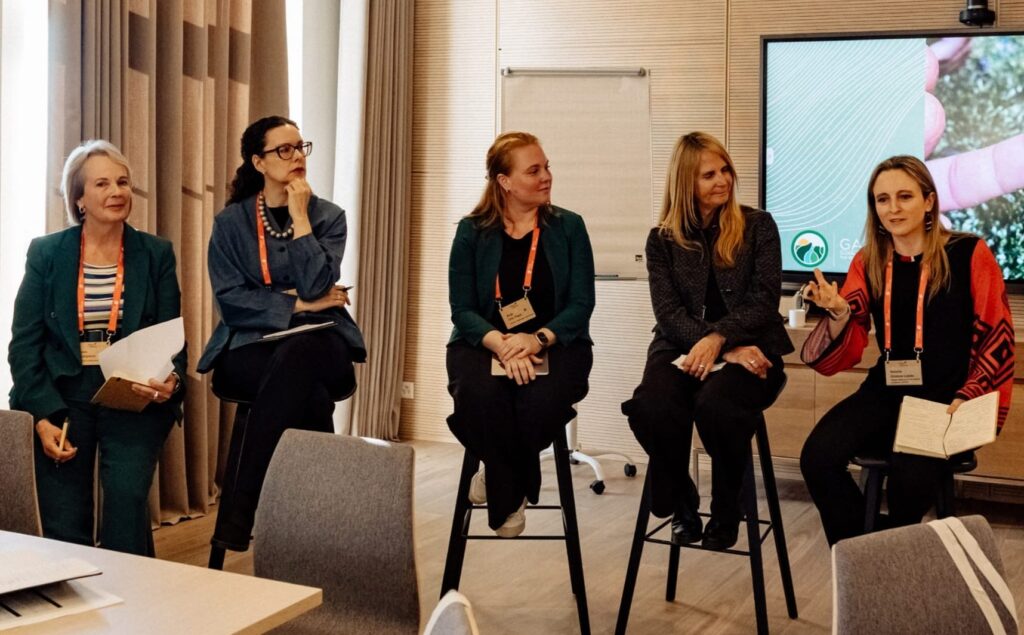
Jane Madgwick, the GCA; Maja Groff, Climate Governance Commission; Anja Olin-Pape, Global Challenges Foundation, Jean Oelwang, Planetary Guardians; and Natalia Greene, Global Alliance for the Rights of Nature.
The below illustration shows that by combining our knowledge, networks and resources, we can move further, faster. The Planetary Guardians and other influential players have a key role to play in moving nations, while the Global Alliance for the Rights of Nature community “gives nature a voice” in decisions affecting valuable landscapes around the world. In particular this is resulting in effective protection of nature through assigning legal rights; the voice of the tiny and rare “resistance frog” was instrumental in saving a whole cloud forest in Ecuador. We need a mind-set shift that recognizes nature as a source of life rather than a resource for people to use.
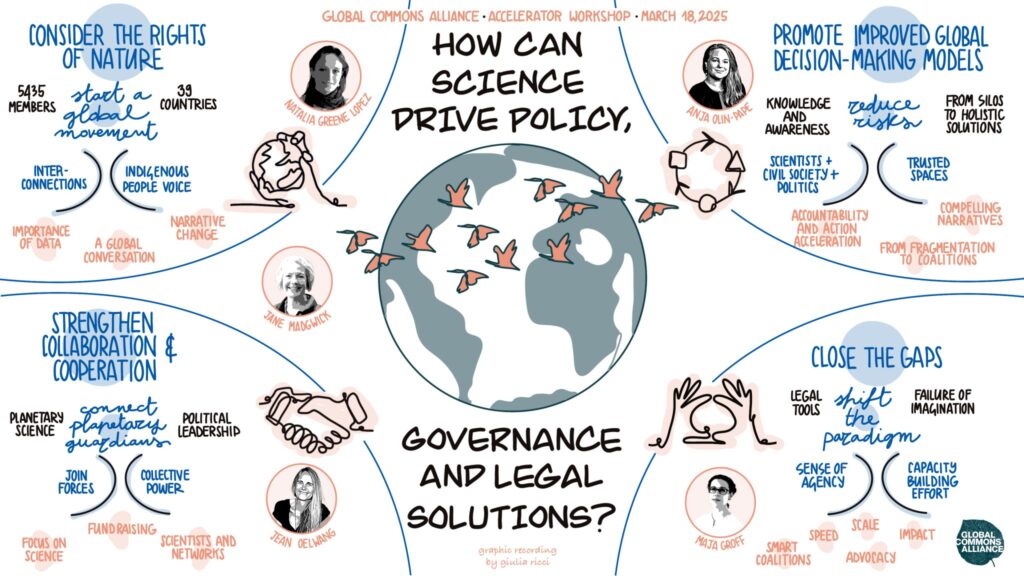
While current geopolitical tensions may stall national action, sub-national leadership has a critical role to play. In a session moderated by Sebastian Schienle, Director of Advocacy, GCA, with Luc Bas, Cerac (Climate Risk Assessment Center of Belgium), and Morten Hojer, City of Copenhagen, the focus was turned to how the Safe and Just science can support resilience and development at the city as well as the country level. From grassroots movements to inter-city coalitions, it was asserted that scientific understanding, collaboration and adaptation are key to healthy communities and economies.
Sub-national leadership has a critical role to play.
Participant GCA workshop
While cities and countries understand that addressing climate change is a shared responsibility globally, this message hasn’t yet “caught on” for nature, even though nature increasingly matters for city dwellers. In this context, applying a risk lens is important alongside highlighting the economic implications of inaction and the benefits of nature-based solutions.
There are moves at the European level to assess the risks and potential economic consequences of approaching tipping points and it is hoped that this can help enable synergy across nation boundaries. This framing is about resilience and human security; a key entry point for actions to conserve and restore the functional integrity of our biosphere.
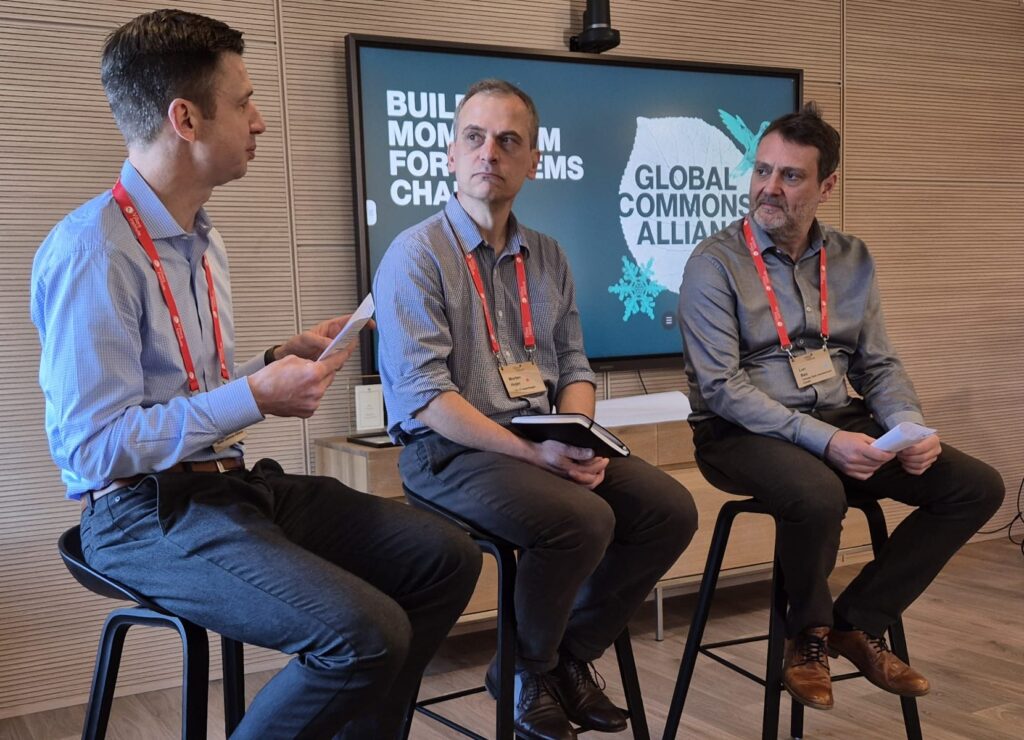
Sebastian Schienle, Director of Advocacy, the GCA; Morten Hojer, City of Copenhage, and Luc Bas, Cerac (Climate Risk Assessment Center of Belgium).
Business is a final piece of the polycrisis puzzle. In a session moderated by Randall Krantz, GCA’s Accountability Accelerator, Erin Billman, Executive Director, the Science Based Targets Network, Gary Baker, IAIA, Alain Vidal, Quantis, and Natasha Matic, Executive Director of the Accountability Accelerator, took part in a session on how science and policy interact with corporate action. Increasingly companies are concerned about the risk of nature loss to their business, yet are reluctant to speak publicly about the actions they’re taking to reduce risk, such as regenerative agriculture.
Speakers relayed that a science-based approach helps companies understand the future risks of current decisions, as well as reduce the costs of inaction. They also now see the wider opportunities and benefits of taking action, as proven by the trailblazing companies who move before them.
Companies now see the wider opportunities and benefits of taking action on nature.
Participant at GCA workshop
With an estimated US $10 trillion benefit from nature-based solutions by 2030, the pivotal role of both pressures and incentives was affirmed by speakers. The legal obligation for environmental impact assessments provides a key point of access to decision-makers, connecting policies through to corporate investments and societal benefits. The opportunity for the Earth System Boundaries Framework to influence best practices on impact assessments was highlighted. Asset owners and pension funds are also well positioned to drive change.

Erin Billman, Executive Director, the Science Based Targets Network; Gary Baker, IAIA, and Natasha Matic, Executive Director of the Accountability Accelerator.
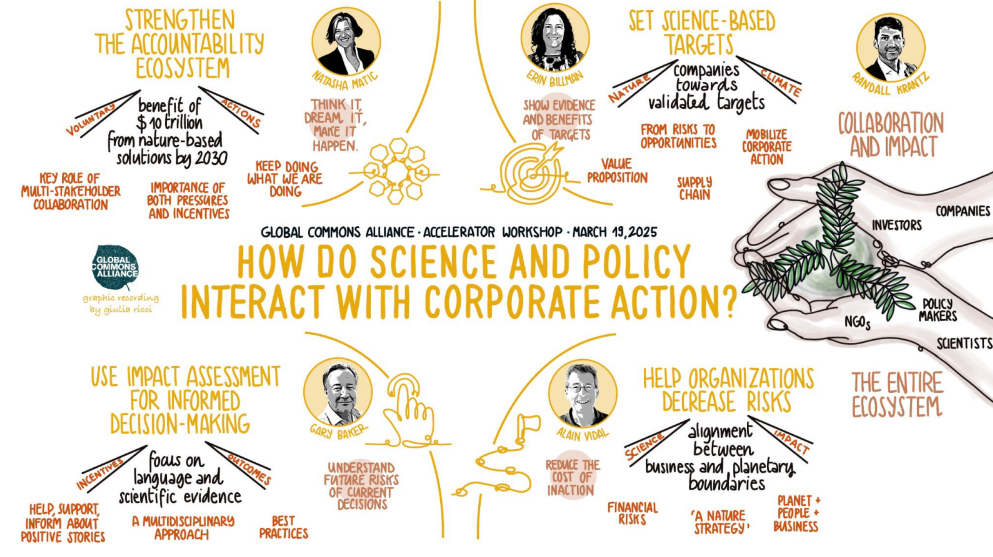
The dangerous state of the Earth system’s limits framed a community roundtable co-hosted by Professor Johan Rockström, Co-chair of the Earth Commission, Keith Tuffley and Victoria Attwood Scott, in which attention was called to the Ocean and the Earth’s Poles which are affecting major shifts in ocean warming. Speakers warned that biodiversity is massively overlooked for its role in climate change, and urged nature metrics as one solution to drive change.
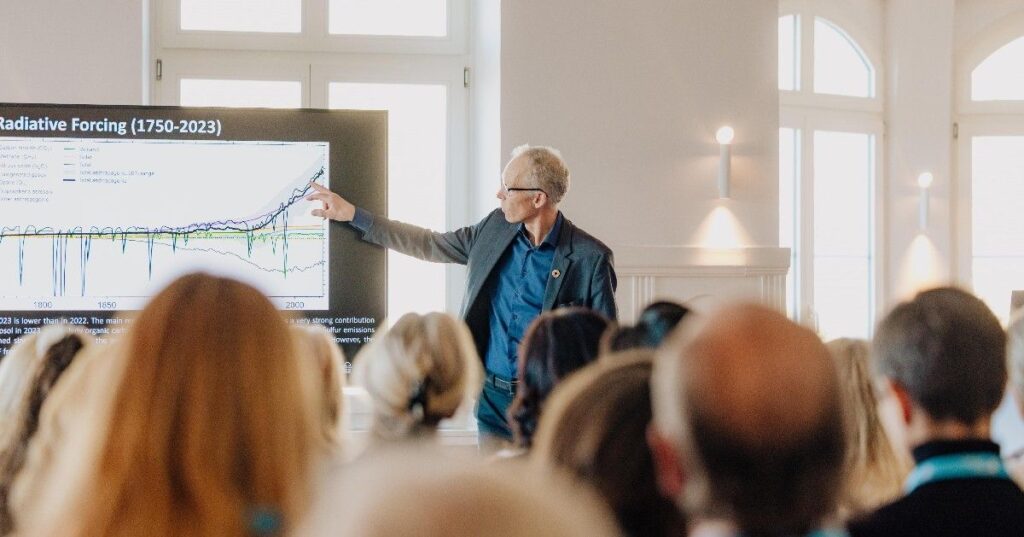
Professor Johan Rockström, Co-chair of the Earth Commission.
As the main Villars Summit session began, financial solutions were central to a session entitled ‘Turning Points for Nature: Harmful Subsidies’, with Caroline Bryant-Bosa, Porticus and GCA Steering Committee; Mark Halle, NatureFinance; Martin Lok, Capitals Coalition; Sheetal Vyas, Virgin Unite and Farooq Ullah, IISD. According to the IPBES Nexus Assessment, US $1.7 trillion is spent each year on public subsidies that damage biodiversity, distort trade, and overuse natural resources.
Looking at how finance can instead be used positively, a session on non-financial reporting to protect nature and biodiversity spotlighted the Taskforce on Nature-related Financial Disclosures (TNFD) and the Science Based Targets Network (SBTN). Tony Goldner, TNFD; Erin Billman, SBTN; Mahima Sukhdev, GIST Impact; Gary Baker, IAIA and Nicole Schwab, World Economic Forum (WEF), focused on how the gathered community could better collaborate to help deliver gains for planetary health.
Nature underpins over half of global GDP – approx. US $44 trillion.
Participant at GCA workshop
In a separate discussion, Mark Gough, Capitals Coalition; Naoko Ishii, Center for Global Commons at the University of Tokyo and GCA Steering Committee; Guido Schmidt-Traub, Systemiq; Sonja Stuchtey, The Landbanking Group and Karen E. Wilson focused on the need to get nature on the balance sheet, given that it underpins over half of global GDP – approximately US $44 trillion – through essential ecosystem services such as food, water purification and climate regulation.

Naoko Ishii, Center for Global Commons at the University of Tokyo and GCA Steering Committee
But the IPBES Nexus Assessment recently found that the global economy is also losing up to US $25 trillion a year due to unaccounted for costs from the agriculture, energy and fishing sectors that impact biodiversity loss, climate change, food security, water scarcity, and human health.
To urgently pivot direction, we must act beyond the siloed thinking of previous decades. Laurence Tubiana, European Climate Foundation; David Obura, Earth Commissioner; Laura Clarke, ClientEarth; Ian Goldin, University of Oxford and Hana Al Hashimi, UN General Assembly, discussed ‘nexus solutions’; this means ideas for any problem such as biodiversity loss, must equally consider intersecting issues such as agriculture.
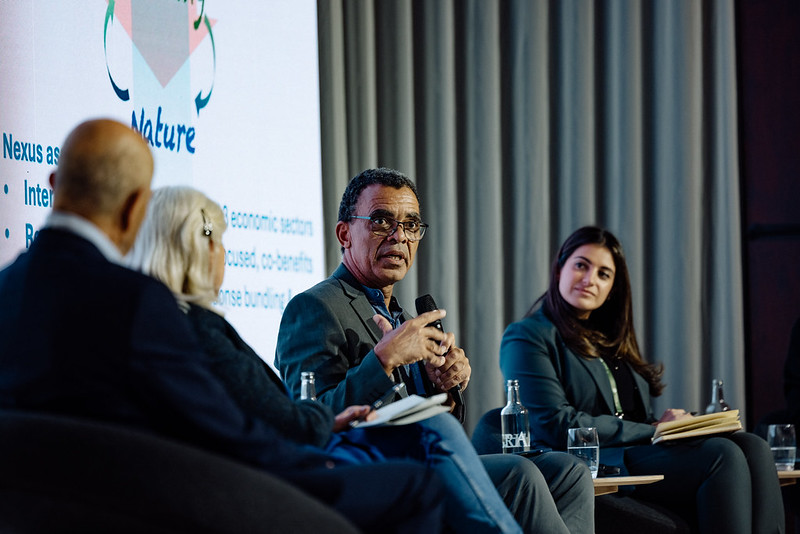
David Obura, CORDIO East Africa and Earth Commissioner
The illustration below draws on key session observations for effective, joined-up action, including the need to mobilize and strengthen mechanisms to engage local communities, Indigenous groups and women. It was agreed that evidence-based frameworks like the Safe and Just Earth System Boundaries provide a foundation for new systems thinking, as the turbulent times we are living through can only be navigated by acting holistically.
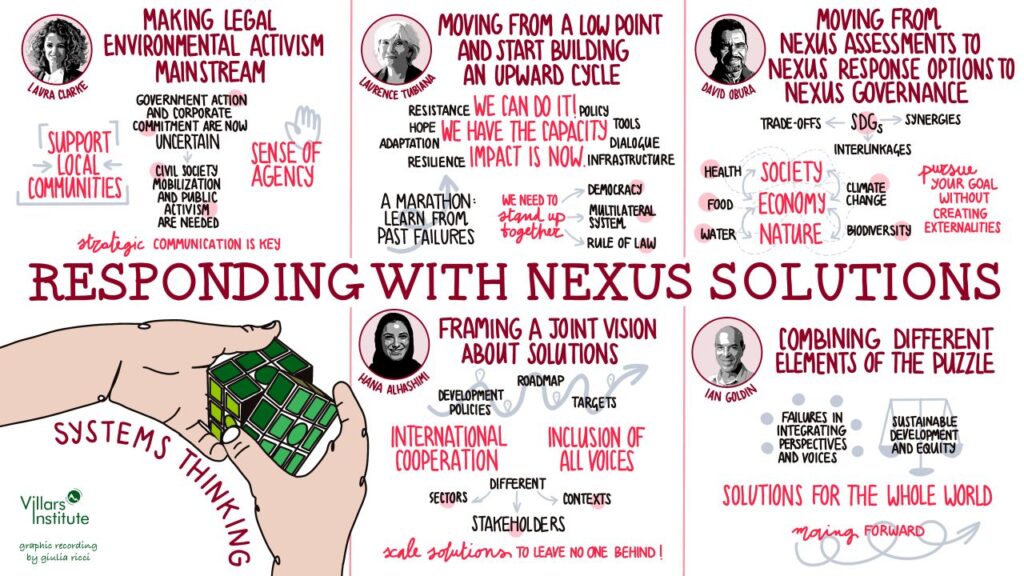
Despite nature’s immense value, natural assets remain largely missing from corporate and financial decision-making. Marco Lambertini, Nature Positive Initiative; Naoko Ishii, Center for Global Commons and GCA Steering Committee; Patrick Odier, Lombard Odier Group and Beatrice Weder Di Mauro, Centre for Economic Policy Research, underscored the importance of moving to a nature-positive economic model that recognizes and invests in nature as a “vital asset” rather than an externality, as biodiversity loss and climate risks escalate.
We need to move to a nature-positive economic model that recognizes and invests in nature as a vital asset.
Participant at Villars Summit

The Villars Summit 2025
Participants agreed that to embed natural capital in balance sheets at the corporate and sovereign level, a top-down push from banks and regulators is needed, which would send a strong push to markets. With Japan issuing its first-ever sustainability disclosure standard last week, this no longer seems an environmentalist’s dream but the global financial market’s reality. The illustration below shows key proposals from the plenary session, including reshaping ‘Nature Positive’ as a measurable global goal rather than just a slogan.
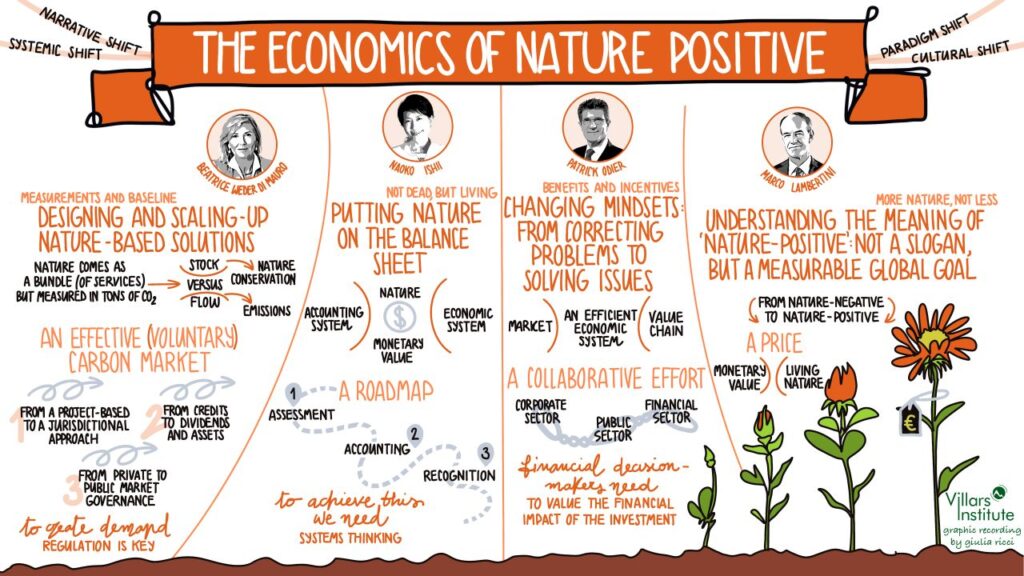
In the session ‘Commitments to Collaborate on Nature Finance & Natural Capital’, Margarita Astralaga, GCA Chair; Akanksha Khatri, WEF and GCA Steering Committee; Mark Gough, Capitals Coalition and GCA Steering Committee, and Karen Hitschke, Building Brides, identified opportunities for closer cooperation within the Villars community in preparation for the 2025 United Nations Climate Change Conference (COP 30) in Belém, Brazil. At the same time, Erin Billman, Yana Gevorgyan, Tony Goldner and Jillian Campbell explored opportunities to measuring and monitoring biodiversity, while a separate session discussed narratives around nature restoration at COP, which included Sweta Chakraborty, We Don’t Have Time and GCA Steering Committee, and Rhett Butler, Mongabay.
No single alliance, organization, government, company or institution can make the difference alone.
Jane Madgwick in opening speech of the GCA workshop
Over the past week of events at Villars, the Global Commons Alliance and our wider network of partners explored new ways to collaborate for systemic solutions that can and will secure a Safe and Just future.
As we continue on the road to COP30 and beyond, we move with the renewed confidence that the urgent need for systems change is shared by a fast growing community of influential leaders whose collective efforts will build peace, security, and resiliency for people everywhere.
That is something we can all unite behind.
- Contact us to get involved
- View all photos from the Villars Summit
